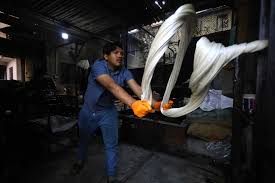KATHMANDU: Nepal’s business of traditional sweet, Chaku, made from jaggery molasses is now experiencing the bitter taste of a shortage of workers which in years might widen the gap between demand and supply.
Rohit Shrestha (19) is the fourth generation within his lineage to continue the business of Chaku (molasses) in the ancient town of Tokha in the outskirts of Kathmandu but things are going to change from his generation onwards. “I am the fourth generation who has been working on this family business of Chaku (molasses) making. I started assisting in the factory from an early age. I recently have completed my intermediate level (+2) and haven’t enrolled in the Bachelor’s level (Graduation). I want to go to foreign country after completion of my studies, where as of now am planning to continue promoting the molasses,” Rohit told reporters.
The rising trend of flying abroad in search of better opportunities and education has been rising in the Himalayan Nation with a population of less than 30 million. The majority of those flying abroad are youths and earning age groups queuing up at the airport ready to take off leaving the elderly behind.
The aroma of boiling stacks of sugar lumps filling the air around the Tokha is fading out in Tokha which is popular for first-class molasses which has high demand in the market. However, the making of molasses is seasonal and the industry only works full-fledged for just two months in a year with production made sparsely based on the demands.
Tokha, an ancient settlement inside Kathmandu Valley, is believed to have been in existence from the Malla Period, long before the unification of Nepal by Prithivi Narayan Shah and currently has around 15 molasses-making home-based industries.
The word “Tokha” has an appendage from a Newa word “Tyokha” meaning sweet and molasses were the main product of this place which has continued over the centuries. The Newa community of Kathmandu valley consume a high volume of Chaku (molasses)- confectionery made from concentrated sugarcane juice, jaggery, ghee and nuts which holds significance on Maghe Sakranti- the first day of the 10th month as per the Lunar calendar.
This process involves melting jaggery, stirring it continuously and then cooling it in clay pots. It is then whipped, slapped, and stretched until it turns dark brown. The confectionery is then weighed, topped with nuts, and packaged. The whole process takes two to three hours.
Rohit’s factory which used to employ about 20 people last year now is hosting 11 struggling to keep afloat the business. The current number also includes his family members who are now assisting in the factory work to continue the business. The situation in coming years can be dire for the small-scale industries that exist in this ancient town within the valley provided the steep rise in immigration culture that is
brewing among the youths and active population group. With this, the sweet business of molasses is now experiencing the bitter taste of a shortage of workers which in years might widen the gap between demand and supply.
“Every year the demand for the Chaku (molasses) is continuing to rise but the shortage of the staff to work in the factory is resulting in the downfall of the supply. Many of the youths are now vying from foreign countries (the Gulf, Australia, Europe and the US) which has resulted in a shortage of staff to work in the factory which has cut the supply in terms of demands,” Buddha Shrestha, the Vice-Chairman of the Tokha Traditional Chaku (Molasses) Conservation Society told ANI.
According to data from the Department of Foreign Employment, nearly 84,000 Nepalis left the country for work in a single month, from mid-November to mid-December, 2024, marking the highest figure recorded in the country’s history of labour migration.
As per the official numbers released by the department,a record-high number of Nepali left the country for employment between mid-November to mid-December (Mangsir, 2081BS). Within a month 83,933 Nepali were issued work permits by the Department of Foreign Employment opening ways for them to travel to 96 countries. This data included 70,500 men and 13,433 women, through both individual and institutional channels. Gulf countries share much of the portion amongst which the United Arab Emirates (UAE), Saudi Arabia, and Qatar stood atop the list. In the review month, 24,769 Nepali obtained new work permits or renewed their work permits to work in the UAE, followed by 18,115 heading to Saudi Arabia, and 14,844 to Qatar.
The number of Nepalis going to Malaysia, another key employment destination, has declined to 4,469, following the imposition of quotas on foreign workers by the Malaysian government. By mid-December of the current fiscal year (2081/82), 317,000 Nepali had left for foreign employment, compared to 278,000 during the same period last year.
The steep rise in number of migrant workers heading for foreign countries also has led to a significant rise in remittances. In the first four months of the current fiscal year, remittance inflows amounted to Rs 521.63 billion, an increase of 9.1 per cent compared to the same period last year.
According to the Nepal Rastra Bank, the central bank of the Himalayan Nation, over 70 per cent of remittances are sourced from the Gulf countries, with a senior official noting, “A large part of remittances is coming from the Gulf countries.” Amongst those leaving the nation are the skilled ones at the top. The breakdown of data released by the Department of Foreign Employment on the basis of issuance of the work permit the number of skilled workers stands high. A total of 53,158 skilled workers have obtained permits to go abroad to work, while 21,716 unskilled workers, 8,780 semi-skilled workers, 470 workers in professional roles and 102 highly skilled professionals obtained work permits to fly abroad for employment.


